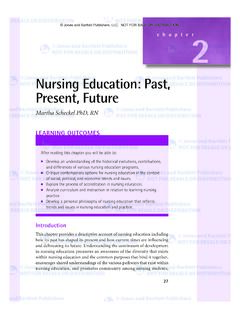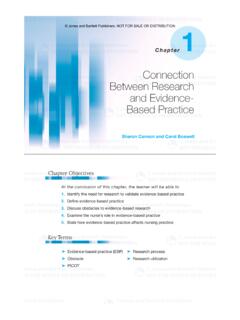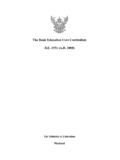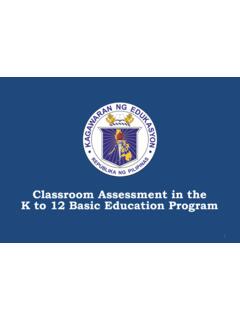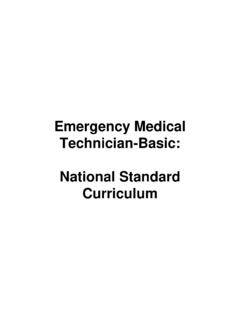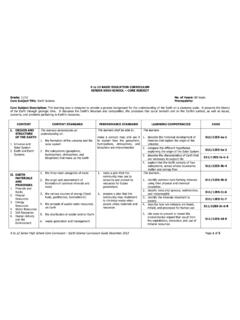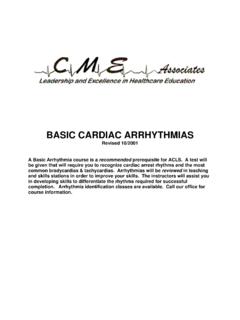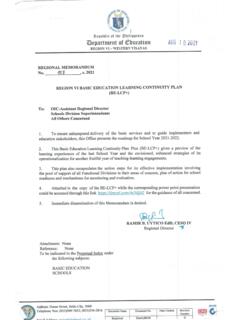Transcription of BASIC CONCEPTS OF PATIENT EDUCATION
1 SectionIBASICCONCEPTS OFPATIENTEDUCATIONS ection I of this book, BASIC CONCEPTS of PATIENT EDUCATION , describes the importanceof teaching and learning in health care and physical and occupational therapy rehabilita-tion as well as the historical development of PATIENT teaching and learning. Section I con-cludes by defining PATIENT EDUCATION within the context of rehabilitation and providingan in-depth exploration of predictors that contribute to effective PATIENT I is divided into the following five chapters:Chapter 1: Significance of PATIENT EDUCATION for Health Care and RehabilitationChapter 2: Historical Outlook of PATIENT EDUCATION in American Health CareChapter 3: Historical Outlook of PATIENT EDUCATION in Physical and OccupationalRehabilitationChapter 4: PATIENT EDUCATION in the Context of Physical and Occupational Reha-bilitationChapter 5: Predictors of Effectual PATIENT 2/5/09 12:29 PM Page 1 Jones and Bartlett Publishers, LLC. NOT FOR SALE OR 2/5/09 12:29 PM Page 2 Jones and Bartlett Publishers, LLC.
2 NOT FOR SALE OR DISTRIBUTIONO bjectivesAfter completing Chapter 1, the reader will be able to: Identify the significance of PATIENT EDUCATION in health care. Discuss the importance of PATIENT EDUCATION in physical and occupationalrehabilitation. Compare and contrast the impact of PATIENT EDUCATION in health care and inrehabilitation. Understand the importance of PATIENT EDUCATION as related to health care and reha-bilitation practices. Identify the general significance and benefits of PATIENT EDUCATION and Significance of PATIENT EDUCATION in Health CareIn contemporary health care, PATIENT EDUCATION is a PATIENT s right and a health care provider sresponsibility. governmental efforts regarding health and PATIENT EDUCATION are illus-trated in the Healthy People 2000and Healthy People 2010initiatives. These initiatives haveencouraged the United States as a whole to participate in health promotion and disease1 SIGNIFICANCE OFPATIENTEDUCATION 2/5/09 12:29 PM Page 3 Jones and Bartlett Publishers, LLC.
3 NOT FOR SALE OR DISTRIBUTIONC hapter 1 Significance of PATIENT EDUCATION for Health Care and Rehabilitation4prevention through exercising, appreciating better health and fitness, avoiding workplaceinjuries, immunizing children against disease, and participating in preventive screeningprograms. The upcoming Healthy People 2020expands the goals for health promotion andpatient or client teaching and learning by incorporating specific health objectives for var-ious races and ethnicities. It also includes a larger, contemporary definition of the conceptof health equality in relation to health risks caused by various genetic differences and pre-dispositions to diseases or VERSUSHEALTHEDUCATIONP atient EDUCATION is a significant component of modern health educationcan be divided into two large categories clinical PATIENT EDUCATION (or clinical teachingand learning) and health EDUCATION . Clinical PATIENT EDUCATION is a planned, systematic,sequential, and logical process of teaching and learning provided to patients and clientsin all clinical is also a continuous teaching and learning process involving thehealth care provider and the PATIENT or client (and/or the PATIENT s family).
4 The goals ofclinical teaching and learning are based on the PATIENT s assessment, evaluation, diagno-sis, prognosis, and individual needs and requirements related to EDUCATION is also a teaching and learning process similar to PATIENT , it concentrates mostly on wellness, prevention, and health promotion. Addi-tionally, health EDUCATION can be provided to individuals, groups, and communities. Thebasic focus of health EDUCATION is to change and improve societal health behaviors. In regardto both contemporary clinical PATIENT EDUCATION and health EDUCATION , patients and clientsare taking a more informed and active role in health care related decisions. This newapproach to health can be attributed to a variety of factors, including educational mate-rials distributed by health care providers, the abundance of medical information found onthe Internet, and clinicians increased involvement in PATIENT EDUCATION . Furthermore, allhealth care providers have been learning new risk assessment techniques in the contextof current health promotion and prevention.
5 The illness-based thinking process has beenchanging to a risk-based one that involves the PATIENT as a collaborator and partner of care,sharing responsibilities with the degree to which risky behaviors are reduceddepends mostly on the PATIENT s understanding of the significance of the risk and the impor-tance of change. In this context, the primary role of the health care provider is that ofpatient educator and supporter, to better help patients progress and effect the needed professionals are increasingly encouraged to involve patients in treatment decisions,recognizing patients as experts with a unique knowledge of their own health and theirpreferences for treatments, health states, and outcomes. Increased PATIENT involvement inhealth care represents an important part of quality improvement of all health care participation in health care assessments has been largely associatedwith better health outcomes. As a result, health care providers need to expand theirpatient-centered care practices.
6 Modern health care has been evolving away from a 2/5/09 12:29 PM Page 4 Jones and Bartlett Publishers, LLC. NOT FOR SALE OR DISTRIBUTION centered model toward a PATIENT -centered model. The PATIENT -centered approach demon-strates the highest quality of care, offering the most effective interventions, including edu-cation, for an individual addition, care that is truly PATIENT -centered considerspatients cultural traditions, personal preferences and values, family situations, andlifestyles. The PATIENT and his or her family are an integral part of the health care team,actively collaborating with health care providers in making clinical , PATIENT clinical teaching and learning is essential in this context because it increases patients responsibility for important aspects of their self-care, monitoring, and continuum of care also assures coordinated and efficient teaching and learning betweenhealth care professionals and providers involved in each PATIENT s OFPATIENTEDUCATION INHEALTHCAREH ealth care institutions are recognizing the benefits of PATIENT EDUCATION in improvingpatients safety and adherence to interventions as well as patients satisfaction.
7 In contem-porary health delivery, PATIENT EDUCATION has the potential to counter the rise in health carecosts by reducing expenses and helping patients manage pricey chronic conditions. Adopt-ing PATIENT EDUCATION programs can help health care providers and organizations producebetter outcomes and enhance quality of care. Effective educational materials can helppatients understand medical complexities while reducing anxiety and increasing compli-ance with instructions. PATIENT educational resources have the ability to change commu-nication into actions and improve health. Furthermore, in modern health care, patienteducation is supported because it adds value to the management of various diseases anddisorders. Specific interventions aimed at increasing the PATIENT s knowledge can improvethe treatment outcomes of many acute and chronic illnesses. For example, when theybecome ill, educated patients remain motivated and adherent with treatment PATIENT involvement in treatment decisions increases motivation, empowerment,adherence, and should receive EDUCATION and training specific and appropriate to the care,treatment, and services provided.
8 PATIENT EDUCATION content should be personalized to eachpatient depending on cultural differences and specific EDUCATION should alsobe available in appropriate reading levels and be customizable to individuals. Successfulpatient EDUCATION is the result of comprehensive, proven solutions that are thoughtfullyset up by health care providers and integrated into the PATIENT health care delivery , an efficient PATIENT EDUCATION program can yield better quality of care in fis-cally responsible health care Significance of PATIENT EDUCATION in Physicaland Occupational RehabilitationIn the 21st century, PATIENT EDUCATION has become an important focus of health care provi-sions. Teaching and learning are essential CONCEPTS to be included in the PATIENT sinter-ventions. From the beginnings of organized rehabilitation services, rehabilitation providersThe Significance of PATIENT EDUCATION in Physical and Occupational 2/5/09 12:29 PM Page 5 Jones and Bartlett Publishers, LLC.
9 NOT FOR SALE OR DISTRIBUTION have been using PATIENT EDUCATION practices to help individuals become actively involvedin the goals, outcomes, and selection of interventions. Physical and occupational thera-pists and assistants, as providers of rehabilitative care, have also been involved in teachingpatients. The role of the therapist in PATIENT EDUCATION has been enlarged to incorporatea variety of learning styles, theories, and educational strategies for patients and and family EDUCATION is not just telling patients what to do, but involves a morecomplex mechanism. This includes adequate selection of teaching and learning strategiesto be able to make an impact on patients outcomes in the clinic and in the continuum ofcare at role of physical and occupational therapists and assistants as educators is nowbecoming more central to their scope of practice than ever before. Therapists have a keyrole in PATIENT teaching and learning. The focus of contemporary PATIENT EDUCATION is tohelp individuals and their families become informed participants to manage their own ill-nesses and to facilitate their adaptive responses to , while consider-ing socioeconomic and cultural factors, rehabilitation providers must be able to teachindividuals activities and techniques to perform in the clinical setting and at home, andalso to facilitate health promotion and prevention discharge from acute care facilities is increasingly forcing patients to be moreindependent in managing their own health.
10 Appropriate teaching and learning meth-ods can increase patients adherence with therapeutic rehabilitation programs and theirindependence in the community. Today, entering the second decade of the 21st century,clinical PATIENT EDUCATION and health EDUCATION have been greatly enhanced in physi-cal and occupational rehabilitation. Therapists use clinical teaching and learning regu-larly in their patients examination, evaluation, plan of care, and interventions. Thegoal of rehabilitation providers is to help their patients learn about the disorder (disease)affecting them and actively participate in the planning of interventions. The overallscope is to assist their patients return to participation in activities they need and wantto regard to health EDUCATION , many physical and occupational therapy practices havebeen increasingly focused on prevention and health promotion. Pre-diabetes and diabetesprevention is just one example of an area where the expanding teaching role of physicaland occupational therapists is helping to positively change patients lifestyles.
